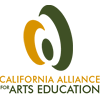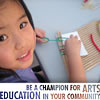You Asked: Advocacy Tips for your District
Whether you are just getting started, or have been at it a while, organizing successful advocacy in your district can be tough. Earlier this month we brought together advocates from all over the state for a webinar, Standing Up for Arts Education. Veterans from the field offered tips on the basics, from building a team, crafting effective messages to picking the right targets. Participants asked questions and posited next steps.
This week on our blog, we answer some of the most popular questions, as well as ones that we didn’t have time to address during the event. Sonoma Alliance for Arts Education advocate, Karin Demarest and the Alliance’s policy director, Joe Landon join us with answers.
CA: Let’s start with one of the most challenging issues. When you are working with a team – usually all volunteers– how do you get people to follow through?
KD: It’s tough! In Sonoma, we created a charter for ourselves, so there is a structure that holds our work, rather than one person or project. We have a chair, a vice chair, a secretary and sub committees. And, we have the charter to go back to when we are starting a project or in the middle of one and maybe getting sidetracked.
JL: In our Local Advocacy Network project, we encourage the leadership teams to distribute the work, so that the load is shared and people are playing to their strengths, whether it’s in-person communication skills, setting up meetings, or writing letters. Spreading out the responsibility seems to help.
KD: Another fundamental part of our group is the relationships we have with each other. That’s something I’ve tried to bring to the work. We laugh, we go out for dinner or drinks after our meetings, there’s a social aspect to it. I try to make it fun.
We are artists and arts organizations, but at times it feels like we could be selling plumbing fixtures — it feels like many of the meetings in the arts have no creativity in them. I believe it’s important to bring creativity to our monthly meetings. At our last meeting, we had a conversation about a piece of art. It was such a success that now we’re planning to have one person bring in a creative exercise or element at every gathering.
CA: With these efforts relying so much on volunteer work, what benefits and attributes can arts organizations offer as a resource to the cause?
KD: Well, the Alliance’s advocacy work aligns really well with the existing missions of many of these organizations. So taking time to come to a meeting and working with community partners is a part of the work they already do.
Beyond that, we’ve tried to really look at how we can support the work of these arts organizations. We want to provide mutual benefit and assistance for all of our partners.
In Sonoma we have partnered with Wells Fargo Center for the Arts, Sonoma County Museum, Charles Schulz Museum, Spreckels Performing Arts Center and Chops Teen Club. They’ve helped us in a number of ways. The organizations’ visibility is a huge asset. They are already known in the community, and so they can leverage their visibility to help our work.
So for instance, as we were planning our Get smART event, one of our officers is the director of education at the Shultz museum. She was able to use her relationships with other museums in the area to get them involved for this event.
They’ve also been really generous with their facilities. Most local advocacy efforts are run out of someone’s home, so having access to facilities is a real help.
CA: How can nonprofit arts organizations get involved in advocacy without endangering their 501(c)(3) status with the IRS?
JL: Nonprofit organizations have an essential role to play in the policy process. Nonprofit organizations include 501(c)(3) organizations (public charities, public foundations, and private foundations), 501(c)(4) organizations (social welfare organizations), 501(c)(5) organizations (labor unions), 501(c)(6) organizations (business leagues), 527 organizations (political organizations), and others. All nonprofits can engage in advocacy, although the scope and extent of their lobbying activities vary according to the tax-exempt status of the organization.
Advocacy allows organizations to serve their constituencies and promote their causes through educating the public and policymakers, conducting research, litigating, organizing, lobbying, and more. Lobbying is just one form of advocacy.
The Alliance for Justice is an organization that can help you learn the ropes for lobbying and nonprofit organizations. For more information:
CA: What messages will resonate most in my community?
JL: The messages we’ve found most effective center around Equity, Access, Economic Opportunity and Quality. There are talking points on our website. But it helps to translate your message to the unique environment in your district. Find out what concerns you share with other community leaders.
Are people concerned about gangs or dropout rates? If so, it might be useful to highlight reports that show how arts programs increase graduation rates and academic performance. If there is community concern about preparing kids for jobs, then presenting findings from research that shows that arts education fosters creativity, collaboration, problem solving and self-direction might be most effective.
CA: Where can people find information about how arts education prepares young people for the workforce?
JL: Pat Wayne, who is heading our countywide Local Advocacy Network project in Orange County, has developed a great presentation that focuses on that. That presentation is available here.
There’s also a report from the Center for Arts and Culture that argues that the ability to thing creatively, communicate effectively and work collaboratively that the arts and humanities develop are essential to prepare students to master fast-paced technological advances, globalization and other major shifts in business.
CA: If you have a question about advocating for arts education in your local school district, email it to [email protected] or check out our facebook page, where we’ll be answering questions.
Next up: How can I raise the profile of the arts at my school and in my community?
One Response to “You Asked: Advocacy Tips for your District”
Samuel Ferullo Says:
April 26, 2010 I was researching this before my afternoon class and found your blog. Just what I was looking for. Great information and timely. Thank you so much










